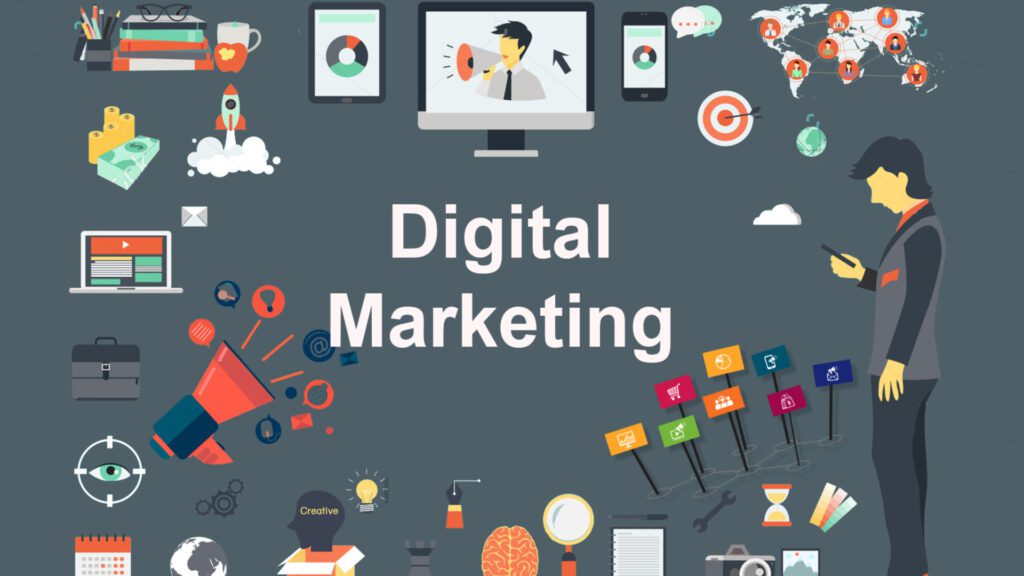Digital Marketing Strategy Frameworks
In the fast-paced realm of digital marketing, having a well-defined strategy is akin to having a roadmap for success. A digital marketing strategy framework serves as the guiding light, providing structure and direction to your efforts. In this blog post, we will delve into the essential components of a robust digital marketing strategy framework, offering insights and practical tips for businesses aiming to navigate the digital landscape effectively.
What is a digital marketing strategy framework?
A framework for digital marketing strategy is essentially a blueprint that delineates marketing processes and workflows, highlighting pivotal components and touchpoints throughout the buyer journey. Implementing marketing initiatives within the confines of a digital marketing strategy framework offers a comprehensive view, ensuring that no crucial elements are overlooked in the execution.
Numerous digital marketing strategy frameworks exist, each tailored to address specific marketing processes or approaches. Some frameworks amalgamate features from others, while some remain distinct. Prior to selecting a digital marketing strategy framework, businesses should ascertain their objectives and priorities, ensuring alignment with a framework that effectively aids in achieving their goals.
What are the benefits of using a digital marketing strategy framework?
Digital marketing strategy frameworks play a crucial role in crafting a successful marketing plan. A significant portion, around 40%, of marketers express dissatisfaction with the effectiveness of their digital marketing strategy. This lack of success often stems from inadequate planning and the utilization of inappropriate digital marketing models for achieving specific marketing objectives.
These frameworks assist marketers in several ways:
- Formulating effective digital marketing plans by outlining essential actions at each stage of the customer journey.
- Identifying obstacles to conversions through a comprehensive analysis of the entire customer journey and past marketing performance.
- Recognizing opportunities to guide customers toward desired actions.
- Preventing gaps in hand-offs by fostering collaboration and coherence among different teams.
- Creating a seamless experience and reducing friction at every customer touchpoint.
In essence, digital marketing strategy frameworks serve as a guiding structure that not only addresses planning deficiencies but also enhances the overall effectiveness of marketing efforts.
Examples of digital marketing strategy frameworks
Below, we’ve listed a few of the most widely used digital marketing strategy frameworks to enhance your digital marketing efforts.
RACE planning
RACE planning is a popular example of a digital marketing strategy framework. RACE stands for Reach, Act, Convert and Engage, and focuses on sales growth. Let’s take a look at the four phases in RACE planning:
- Reach: Building brand awareness and visibility are the main goals of the ‘Reach’ process. This includes generating website traffic, external links, social media interactions, and earned media.
- Act: ‘Act’ entails persuading visitors to take a specific action on a website, sales page, or social media account. Bounce rate, average time spent on a web page, and the number of subscribers are key metrics for this stage.
- Convert: ‘Convert’ focuses on converting passionate followers into paying clients. Conversion rate, number of leads, sales, and revenue growth are key performance indicators.
- Engage: ‘Engage’ is the process of developing authentic relationships with customers to increase retention. Customer churn rate and repeat customer rate are two critical performance measures.
Marketing funnel
This digital marketing strategy framework is widely employed for illustrating the customer journey, delineating the stages from initial discovery to the ultimate purchase. The framework is commonly structured into four distinct stages, forming a marketing funnel:
- Awareness: At the Awareness stage, prospective customers first encounter a brand, typically through direct digital marketing channels such as targeted online ads or indirect channels like search engine optimization (SEO).
- Interest: The Interest stage occurs when the customer’s curiosity is sufficiently sparked, leading them to explore the company’s owned media channels to gain deeper insights into the offered products or services.
- Consideration: During the Consideration stage, potential customers transition to actively contemplating a product as a viable solution to their needs or problems. This involves a more in-depth evaluation of the product’s features and benefits.
- Action: The final stage, Action, marks the customer’s decision to make a purchase and patronize the company. This is the culmination of the customer journey, where the marketing efforts successfully lead to a conversion.
This framework provides a structured depiction of the customer’s progression through key phases, aiding marketers in tailoring strategies to each stage of the journey.
Flywheel model
The flywheel model represents a customer-centric approach to digital marketing strategy, aiming to optimize the customer journey by eliminating any “frictions” that might impede the buyer process, such as inconsistent brand messaging.
In essence, the flywheel model dissects the customer journey into three pivotal phases:
- Attract: The Attract phase concentrates on capturing customers’ attention through a blend of organic and inorganic digital marketing strategies. The goal is to generate interest and bring potential customers into the orbit of the brand.
- Engage: Moving to the Engage phase, the focus is on building relationships with the audience, creating awareness about the brand’s products, and fostering a connection with potential customers. This phase aims to deepen the brand-customer relationship.
- Delight: The Delight phase centers on supporting and enabling customers to have positive experiences and meet their needs. By providing exceptional service and exceeding customer expectations, this phase contributes to customer satisfaction and loyalty.
Crucially, when customers have positive experiences with a brand or company, they are more likely to become brand advocates, recommending the brand to their network. The flywheel model, thus, places a strong emphasis on customer satisfaction and positive interactions throughout the entire customer journey.
Forrester’s 5 Is
Forrester’s 5 Is model provides a comprehensive perspective on the evolving nature of customer-brand relationships by examining the levels of involvement, interaction, intimacy, and influence that individuals have with a brand over time. This model challenges the traditional marketing funnel, advocating for continuous engagement throughout a product’s life cycle to foster successful digital marketing campaigns.

Let’s delve into Forrester’s 5 Is:
- Involvement: Involvement entails actively engaging customers with the brand or product. Metrics such as page views, website traffic, and average time spent on a page quantify this engagement, reflecting the extent to which customers interact with the brand.
- Interaction: The Interaction stage encompasses various customer activities, including making a purchase, subscribing to a newsletter, or sharing photos related to the brand or product. It represents tangible actions that reflect customer engagement.
- Intimacy: Intimacy delves into the sentiments and emotions underlying customer actions. Examples include the emotional nuances expressed in product reviews, social media mentions, or customer testimonials. It provides insights into the personal and emotional connections customers form with the brand.
- Influence: Influence gauges the likelihood of customers and external stakeholders recommending your products to others. This stage can be measured through indicators such as share rates, referrals, and online mentions, showcasing the impact your brand has on a broader audience.
- Individual: The Individual stage emphasizes a personalized focus on a single person rather than a collective group or community. It’s a more granular and specific approach, tailoring interactions and experiences to the unique preferences and needs of individual customers.
Forrester’s 5 Is model advocates for a shift from a linear funnel approach to a dynamic and continuous engagement strategy, recognizing the nuanced and evolving nature of customer-brand interactions.
McKinsey’s consumer decision journey
Customers navigate their purchase decisions through a multi-step process, influenced by various criteria. The consumer decision journey unfolds in the following stages:
- Trigger: The journey commences with a trigger, wherein users identify a problem or need that necessitates a product or service solution. This realization serves as the starting point for the consumer decision journey.
- Initial Consideration Set: During the Initial Consideration Set stage, individuals contemplate a purchase and reflect on the brands that immediately come to mind. This set typically includes familiar brands that consumers associate with addressing their needs.
- Evaluation: Consumers actively seek information from diverse sources, including product reviews and online platforms, to assess which brands align with their specific wants or needs. The Evaluation stage is characterized by a thorough exploration of available options.
- Buying: Having gathered information during the Evaluation stage, consumers filter through alternatives and make a purchase decision. This stage marks the culmination of the decision journey as the consumer selects a specific brand to fulfill their requirements.
- Ongoing Exposure: Following the purchase, customers develop post-buy expectations that shape their ongoing exposure to the brand. The experience with the product or service influences their future decision-making processes.
- Loyalty Loop: Depending on the degree to which the product meets their needs, customers may transition into the Loyalty Loop. This phase involves the development of brand loyalty and advocacy, where satisfied customers become advocates, attracting additional customers to the business.
Understanding and navigating these stages of the consumer decision journey is vital for businesses aiming to effectively engage with their audience, build brand loyalty, and influence future purchase decisions.
Understanding Your Business Objectives:
At the core of any successful digital marketing strategy is a deep understanding of your business objectives. Before delving into tactics, take the time to clearly define your goals. Whether it’s increasing brand awareness, driving website traffic, or boosting conversions, a solid strategy begins with a clear sense of purpose.
Know Your Audience:
A digital marketing strategy is only as effective as its ability to resonate with the target audience. Conduct thorough audience research to identify demographics, preferences, and behaviors. This knowledge will inform your content creation, channel selection, and overall messaging strategy.
Choosing the Right Channels:
The digital landscape offers a plethora of channels, from social media and email marketing to search engine optimization (SEO) and paid advertising. A crucial aspect of your framework is selecting the channels that align with your business goals and where your target audience is most active.
Content is King:
Content lies at the heart of any successful digital marketing strategy. Develop a content plan that speaks directly to your audience, addresses their pain points, and provides value. Whether it’s blog posts, videos, or infographics, tailor your content to the preferences of your audience.
SEO and Website Optimization:
Ensure that your digital presence is easily discoverable by optimizing for search engines. Implement a robust SEO strategy, focusing on keyword research, on-page optimization, and link-building. Additionally, prioritize a user-friendly website design and seamless navigation for an enhanced user experience.
Paid Advertising:
Leverage paid advertising strategically. Whether it’s Google Ads, social media ads, or display advertising, allocate your budget effectively and craft compelling ad creatives. Monitor and adjust your campaigns based on performance data to maximize ROI.
Social Media Engagement:
Social media is a powerhouse for brand building and audience engagement. Develop a social media strategy that aligns with your brand voice, encourages interaction, and promotes community building. Consistent and authentic engagement will foster brand loyalty.
Analytics and Optimization:
Regularly track the performance of your digital marketing efforts using analytics tools. Measure key performance indicators (KPIs) such as website traffic, conversion rates, and social media engagement. Use these insights to refine and optimize your strategy continuously.
Conclusion
In the dynamic landscape of digital marketing, a well-crafted strategy is your compass to success. By following a comprehensive digital marketing strategy framework that aligns with your business objectives, understands your audience, and leverages the right channels, you pave the way for sustained growth and meaningful connections with your target audience. Embrace the digital era with a strategy that not only adapts to change but leads the way forward.







